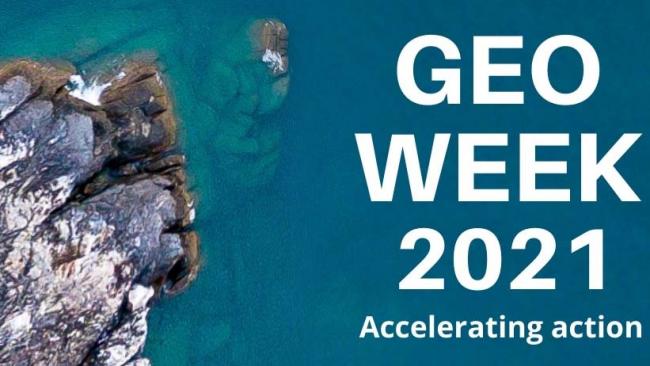GEO Week 2021 kicked off on Monday morning with the first ever Group on Earth Observations (GEO) Youth Track. The Youth Track, which opened with a town hall meeting, aims to bring young voices into the GEO process and, by the end of the meeting, establish a youth community of practice that is focused on, and led by, youth.
Opening the meeting, Florian Franziskakis, GEO Secretariat, highlighted it as an occasion to bring together young people interested in Earth observations and sustainable activities. Yana Gevorgyan, Director, GEO Secretariat, emphasized the role of young people in achieving the transformational change that the world needs. She underlined that “we want to integrate youth voices into the work of GEO and build a systematic, sustained relationship.”
Nathalie Pettorelli, Senior Scientist, Zoological Society of London, and GEO Programme Board member, presented GEO’s Equality, Diversity and Inclusion (EDI) Statement. She explained that generational diversity and ensuring youth representation in GEO’s activities are priorities of GEO’s EDI subgroup.
In the subsequent discussions moderated by Francis Omondi, New Partnership for Africa’s Development/Africa Peer Review Mechanism (NEPAD/APRM) Kenya Secretariat, speakers considered how GEO is building leadership and advocacy within its work, engaging with different GEO communities including the private sector and the possibility of internships supported by GEO.
Following the Youth Track, the GEO Week 2021 Industry Track opened. Master of Ceremonies, Kamal Ramsingh, Founder, CEO, ZASPACE, underscored that partnerships have proven to be a real secret source of growth around the world.
By video address, Yana Gevorgyan emphasized public-private partnerships as the way of the future and encouraged companies to enter into a dialogue with GEO on where to innovate.
Will Marshall, Co-Founder and CEO of Planet, highlighted Earth observation satellite activities based on imaging the whole world, every day. He said they track changes, and make those changes visible, accessible and actionable, in order to move from awareness of effects to action based on data.
Emmanuel Pajot, Secretary General, European Association of Remote Sensing Companies (EARSC), discussed the benefits of Earth observations across six parameters: economic, environmental, regulatory, entrepreneurship and innovation, science and technology, and societal benefits. He provided case study examples of: mapping sea ice off Greenland; dredging in the Maldives' forestry management in Sweden; and water quality management in Germany and Spain.
Keith VanGraafeiland, Esri, presented on an Esri and GEO Blue Planet collaboration on developing an index for coastal eutrophication for all countries, which can be used to promote understanding and reduce coastal eutrophication. He explained that the methodology for the project is driven by satellite data that regularly measures chlorophyll concentrations at the surface of the ocean globally.
Valrie Grant, Founder and Chairperson, GeoTech Vision, made the case for diversity in terms of fostering belonging and fairness, underscoring that the business case for diversity is well documented with a proven correlation between profitability, and gender and ethnical diversity.
Subsequently, participants heard presentations from nine small, medium and micro-sized enterprises (SMMEs) on their work on Earth observations:
- Peter Baumann, Founder, Rasdaman, presented the raster data manager, actionable data cubes;
- Katia Stambolieva, Founder, Cosmos Pics, presented her company’s satellite imaging platform;
- Dietrich Heintz, CEO and Founder, Cropix, described his company’s web geo-information systems (GIS) platform for presenting map productions;
- Juan Peña Ibáñez, CEO & Co-Founder, explained that his company focuses on detecting, characterizing and forecasting oil spills from space through an EOS Viewer;
- Feng Wenhui, Guangzhau iMapCloud Intelligent Technology Co. Ltd, said her company provides ultra-low altitude drone remote sensing network operation services and industry solutions;
- Saurabh Channan, CEO, terraPulse Inc, described his company’s work in developing remotely-sensed products to provide measurable and quantifiable insights about the Earth’s terrestrial surface. He highlighted the terraView Platform as a visualization tool for quickly assessing and interacting with data;
- Eldrige de Melo, Satellogic, explained that his company builds small satellites to democratize access to satellite imagery and offers imagery, artificial intelligence solutions for planetary scale insights; and dedicated satellite constellations, among others;
- Hilda Manzi, Director and Co-Founder, Geospatial Research International, presented on the COLWED (Cost of Land and Wetland Degradation) Tool, intended to be used for valuation modelling in the ecosystem valuation decision making process; and
- Joel Cumming, Chief Technology Officer, SkyWatch, described EarthCache as a simplified way of purchasing commercial satellite images, intended to be a “one-stop shop” for this purpose.
To receive free coverage of global environmental events delivered to your inbox, subscribe to the ENB Update newsletter.




















